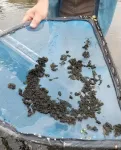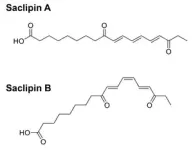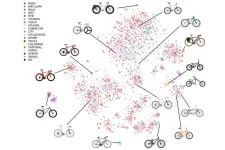Sustainable cosmetics: harnessing cyanobacteria for natural active ingredients
Scientists discover two novel compounds with anti-aging and UV-absorbing properties in a freshwater cyanobacterium endemic to Japan
2023-10-20
(Press-News.org)
The cosmetics industry is turning towards natural alternatives to chemical agents used in products to pave way towards a more sustainable future. Researchers are searching for nature-derived active ingredients for skincare products through extensive bioprospecting research. In this regard, cyanobacteria, with their remarkable metabolic capacity, are a promising source of such agents. Having existed on Earth for nearly 3.5 billion years, these photosynthetic organisms have adapted to various environmental conditions, including extreme environments. Aphanothece sacrum, a cyanobacterium endemic to Japan and cultivated as a food source on farms in Fukuoka Prefecture, is already being studied for the capacity to produce active ingredients like sacran, a water retaining polysaccharide.
Now, a team of researchers, led by Professor Hakuto Kageyama from Meijo University, Japan, have discovered two novel compounds—saclipin A and saclipin B—produced by in A. sacrum. The researchers were originally evaluating environmental stress tolerance mechanisms in cyanobacteria and exploring whether A. sacrum contained mycosporine-like amino acids (MAAs), which can absorb UV radiation and possess antioxidative and antiglycative properties, when they chanced upon the discovery of the two types of saclipins. When asked about his motivations for pursuing the research, Prof. Kageyama explains, “Presently, most UV-absorbing ingredients are chemically synthesized. They pose a significant environmental risk and can inhibit the growth of organisms like seaweed and corals. Natural ingredients will go a long way in improving the environmental credentials of cosmetics and pharmaceuticals as industries pursue ways to be more environmentally conscious.” The team’s findings were published in the Journal of Agricultural and Food Chemistry on 10.1021/acs.jafc.3c05152.
To study the cyanobacterial metabolites, the team needed to isolate them from A. sacrum cells. First, the researchers prepared an organic extract from dried A. sacrum and examined it for UV-absorbing compounds. Next, they purified target metabolites with absorption spectra close to 320 nm, a wavelength falling within the bandwidth for UV radiation. Finally, mass spectroscopy and nuclear magnetic resonance were used to determine the chemical structure of the purified compounds. Touching on the significant findings from the study, Prof. Kageyama says, “Structurally, the saclipins were completely different from known UV-absorbing compounds derived from cyanobacteria, such as MAAs and scytonemin. They absorbed UV radiation, scavenged damaging oxygen free radicals, and inhibited the glycation of collagen and elastin. Taken together, these characteristics show they have the potential to slow down aging.” By exposing A. sacrum to various environmental stressors to understand the growth conditions that induced its synthesis, the team determined that saclipin production was enhanced under drought stress. Additionally, they found a unique property of the saclipins—photoisomerization. Saclipin A could be converted to saclipin B under fluorescent light irradiation. This property is advantageous because it allows for quick adjustment of saclipin ratios in product formulations, depending on the intended use.
Prof. Kageyama is keen to conduct further research on the saclipins. “A. sacrum is cultivated as a food source in Japan. If we can understand how to produce the saclipins at scale, there is the potential to develop them as an edible anti-aging supplement,” he says. He is hopeful that further research will draw attention towards the conservation of this freshwater cyanobacterium. “Such findings could serve as the catalyst for broader conservation efforts. Sustainable aquaculture production could go a long way to securing A. sacrum’s future,” he concludes.
END
[Attachments] See images for this press release:


ELSE PRESS RELEASES FROM THIS DATE:
2023-10-20
Consistently sleeping less than five hours a night might raise the risk of developing depressive symptoms, according to a new genetic study led by UCL (University College London) researchers.
Historically, poor sleep has been seen as a side effect of mental ill health, but this study found that the link between sleep and mental illness is more complex.
The study, published in the journal Translational Psychiatry, analysed data from people with an average age of 65 and found short sleep was associated with the onset of depressive symptoms.
Lead author Odessa S. Hamilton (UCL Institute of Epidemiology ...
2023-10-20
Dzemila Sero, now Migelien Gerritzen Fellow at the Rijksmuseum and former postdoc at the Centrum Wiskunde & Informatica, together with a team of researchers from the Rijksmuseum, Leiden and Cambridge University, examined the terracotta sculpture Study for a Hovering Putto attributed to Laurent Delvaux (1696 - 1778) and housed in the Rijksmuseum permanent collection.
The methodology and findings were published open access in Science Advances in a paper with title "Artist profiling using micro-CT scanning of a Rijksmuseum terracotta sculpture".
To acquire preserved impressions on the sculpture, researchers ...
2023-10-20
Researchers at Baylor College of Medicine and the University of Michigan conducted a phase I pilot study to assess the feasibility of using potato starch as a dietary intervention to modify the gut microbiome in bone marrow transplant patients. The study, which appears in the journal Nature Medicine, is the first part of a two-phase ongoing clinical trial evaluating the effect of modifying the microbiome on the incidence of graft-versus-host disease (GVHD), a major complication that develops in up to half ...
2023-10-20
Artificial intelligence (AI)—of ChatGPT fame—is increasingly used in medicine to improve diagnosis and treatment of diseases, and to avoid unnecessary screening for patients. But AI medical devices could also harm patients and worsen health inequities if they are not designed, tested, and used with care, according to an international task force that included a University of Rochester Medical Center bioethicist.
Jonathan Herington, PhD, was a member of the AI Task Force of the Society for Nuclear Medicine and Medical Imaging, which laid out recommendations on how to ethically develop and use AI medical devices in two papers published ...
2023-10-20
Pregnant people who gained more than the now-recommended amount of weight had a higher risk of death from heart disease or diabetes in the decades that followed, according to new analysis of 50 years of data published in The Lancet and led by researchers from the Perelman School of Medicine at the University of Pennsylvania. The group studied a large national data set that stretched from when a person gave birth through the next five decades, assessing mortality rates to show the potential long-term effects of weight gain in pregnancy. Higher risk of death was found for all weight groups studied — including those defined ...
2023-10-20
A first-of-its kind hormone replacement therapy that more closely replicates the natural circadian and ultradian rhythms of our hormones has shown to improve symptoms in patients with adrenal conditions. Results from the University of Bristol-led clinical trial are published today [20 October] in the Journal of Internal Medicine.
Low levels of a key hormone called ‘cortisol’ is typically a result of conditions such as Addison's and Congenital Adrenal Hyperplasia. The hormone regulates a range of vital processes, ...
2023-10-19
URBANA, Ill. – Married couples and long-term romantic partners typically engage in a variety of behaviors that sustain and nourish the relationship. These actions promote higher levels of commitment, which benefits couples’ physical and psychological health. A new study from the University of Illinois Urbana-Champaign looks at how such relationship maintenance behaviors interact with satisfaction and commitment.
“Relationship maintenance is a well-established measure of couple behavior. In our study, we measured it with five main categories, ...
2023-10-19
NASA’s James Webb Space Telescope has discovered a new, never-before-seen feature in Jupiter’s atmosphere. The high-speed jet stream, which spans more than 3,000 miles (4,800 kilometers) wide, sits over Jupiter’s equator above the main cloud decks. The discovery of this jet is giving insights into how the layers of Jupiter’s famously turbulent atmosphere interact with each other, and how Webb is uniquely capable of tracking those features.
“This is something that totally surprised us,” said Ricardo Hueso of the University of the Basque Country in Bilbao, Spain, lead author on the paper ...
2023-10-19
ABSTRACTS: LBA71, 1088MO, 95MO, LBA48, 1082O, 1085O, LBA34, 243MO
MADRID ― The University of Texas MD Anderson Cancer Center’s Research Highlights provides a glimpse into recent basic, translational and clinical cancer research from MD Anderson experts.
This special edition features upcoming oral presentations by MD Anderson researchers at the 2023 European Society for Medical Oncology (ESMO) Congress focused on clinical advances across a variety of cancer types. Highlights include a combination strategy for EGFR-mutant metastatic lung cancer, updated results for a Phase ...
2023-10-19
ChatGPT and other deep generative models are proving to be uncanny mimics. These AI supermodels can churn out poems, finish symphonies, and create new videos and images by automatically learning from millions of examples of previous works. These enormously powerful and versatile tools excel at generating new content that resembles everything they’ve seen before.
But as MIT engineers say in a new study, similarity isn’t enough if you want to truly innovate in engineering tasks.
“Deep generative models (DGMs) are ...
LAST 30 PRESS RELEASES:
[Press-News.org] Sustainable cosmetics: harnessing cyanobacteria for natural active ingredients
Scientists discover two novel compounds with anti-aging and UV-absorbing properties in a freshwater cyanobacterium endemic to Japan




